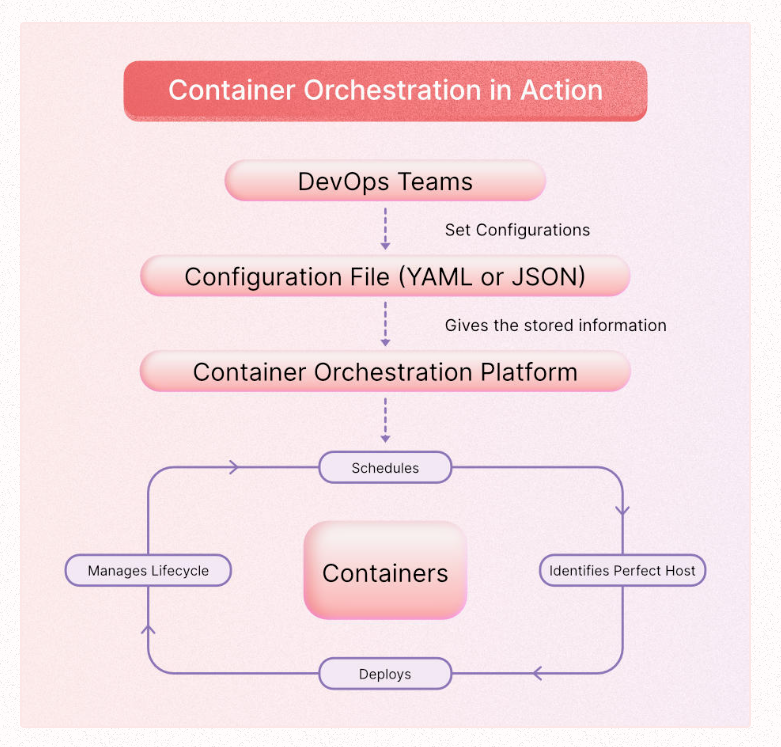Containerization technologies have completely changed the way certain applications are developed, deployed, and managed. Containerization orchestration tools offer several benefits, including the ability to scale and deploy applications more efficiently.
- Understanding Container Orchestration
- Kubernetes: The De Facto Standard
- Docker Swarm: Simplifying Container Orchestration
- Apache Mesos: Power Meets Flexibility
- Choosing the Right Tool: Considerations and Recommendations
- Conclusion
- Additional Resources and Links
Understanding Container Orchestration
When employing containerization, orchestration tools are often used to simplify and streamline container and microservices management, a practice known as “container orchestration.” Container orchestration involves automating the deployment, scaling, maintenance, and management of containerized applications.

//middleware.io/blog/what-is-container-orchestration/
Let’s go through a few key features of container orchestration.
Container deployment and scaling
Container orchestration tools can be useful for efficiently deploying containers across a cluster of machines and scaling them according to demand.
Load balancing
Load balancing is a method of distributing network traffic among a set of resources that support an application. It ensures that no single server is overloaded with too much demand. Container orchestration tools can help with efficiently distributing incoming traffic across multiple containers, thereby optimizing resource utilization and ensuring resource availability.
Service discovery
Service discovery refers to the automatic detection and registration of services, as well as enabling communication between different components of a distributed application.
Fault tolerance and self-healing
Container orchestration tools can help detect failures and automatically recover from them. This ensures the continuous availability of the application.
Updates and rollbacks
With a container orchestration tool, you can easily implement updates to applications and roll back to a previous version if bugs arise.
Resource utilization optimization
Container orchestration tools can be used to optimize resource management and minimize the wastage of valuable resources.
Comparison Time: Kubernetes vs. Docker Swarm vs. Apache Mesos
Let’s see how Kubernetes, Docker Swarm, and Apache Mesos compare in terms of how well they fulfill the key features listed above.
Kubernetes: The De Facto Standard
Kubernetes has become synonymous with container orchestration. However, organizations should be aware of its potential drawbacks such as complexity and resource requirements.
Strengths
1. Scalability: Kubernetes excels in horizontal scaling of applications. It easily deploys and scales containers across multiple nodes.
2. Rich ecosystem: Kubernetes is more than a standalone tool; it’s a vast ecosystem made up of various extensions and third-party tools. These augment its functionality, allowing Kubernetes to address a wide range of use cases.
3. Community support: Kubernetes benefits from a large and vibrant community. Continuous developments and regular improvements enhance its functionality. Additionally, a wealth of resources, including documentation, tutorials, and blogs, make Kubernetes accessible to anyone who needs it.
4. Declarative configuration: Kubernetes takes a declarative form of configuration, which allows the user to specifically choose the state of their applications. The system will then continually maintain the chosen state.
5. Service discovery and load balancing: Kubernetes simplifies traffic management across containers with its built-in service discovery and load balancing.
Weaknesses
1. Complexity: The richness of features in Kubernetes can introduce complexity. New users may face a steep learning curve.
2. Resource hungry: Kubernetes can be resource-intensive, requiring significant computational power and memory usage. This aspect must always be taken into account when deploying Kubernetes in smaller environments.
3. Barriers to entry: For many users, the primary obstacle to adopting Kubernetes is the considerable amount of time and resources required to set up a Kubernetes cluster. This is particularly challenging for less experienced and small teams.
4. Overhead: Once again, smaller organizations and those with simpler requirements may find the overhead involved in managing Kubernetes to be too burdensome. As such, they might choose a simpler alternative instead.
Docker Swarm: Simplifying Container Orchestration
Docker Swarm simplifies container orchestration; however, it lacks some advanced features present in Kubernetes.
Strengths
1. Ease of use: Docker Swarm, being part of the Docker ecosystem, is designed with user-friendliness in mind. It uses Docker commands, which makes it accessible for those already familiar with Docker.
2. Docker integration: Docker Swarm is integrated directly into Docker, eliminating the need for additional tools. This simplifies the containerized workflow, making it more streamlined.
3. Scalability: Docker Swarm excels at efficiently scaling applications, making it particularly well-suited for smaller projects and applications with straightforward requirements.
4. Compatibility: Docker Swarm is compatible with existing Docker Compose files, simplifying the transition from local to production deployment.
5. Built-in load balancing: As with Kubernetes, Docker Swarm provides built-in load-balancing functionality to manage traffic across containers.
Weaknesses
1. Feature set and flexibility: Kubernetes offers some advanced features not available in Docker Swarm, making Kubernetes better suited for large and complex deployments. Consequently, Docker Swarm may be less flexible for advanced and complex use cases.
2. Community and ecosystem: While Docker boasts a strong community, it’s not as extensive as the Kubernetes' in terms of community-related resources.
Apache Mesos: Power Meets Flexibility
Apache Mesos offers powerful features, but its complexity may pose challenges for less experienced users.
Strengths
1. Resource efficiency: Apache Mesos is renowned for its resource efficiency. This makes it an excellent choice for organizations seeking to optimize their resource utilization.
2. Flexibility: Apache Mesos offers a flexible framework that allows users to plug in various orchestration models. Marathon and Chronos are two examples used for long-running applications and job scheduling, respectively.
3. Scalability: Apache Mesos shines at horizontal scaling, adjusting computing nodes to accommodate workload fluctuations. This capability enables Apache Mesos to easily manage large clusters and diverse workloads.
4. Multitenancy: Apache Mesos supports multitenancy (i.e., multiple customers of a cloud vendor using the same computing resources), thus facilitating the effective sharing of resources among multiple users and teams.
5. Fault tolerance: Fault tolerance, which ensures reliable operation of applications even in the face of node failures, is built into Apache Mesos.
Weaknesses
1. Complexity: Apache Mesos is extremely powerful, but its complexity can be daunting. Setting up and configuring it may require significant time and effort. As a result, less experienced users may find it too challenging.
2. Community and Adoption: Kubernetes and Docker Swarm both have higher levels of adoption and community support compared to Apache Mesos.
3. Learning Curve: Learning Apache Mesos usually involves overcoming a steep learning curve.
Choosing the Right Tool: Considerations and Recommendations
When choosing an orchestration tool, take into account the following factors and recommendations.
Considerations
1. Project size and complexity: Both Kubernetes and Apache Mesos excel at managing large-scale and complex operations. For smaller projects and organizations with less demanding requirements, Docker Swarm may be the better option due to its simplicity and ease of use.
2. Existing ecosystem: When selecting an orchestration tool, it’s important to consider your team or organization’s familiarity with existing tools and ecosystems. For example, if your organization is already using Docker, Docker Swarm may be the best choice for an orchestration tool.
3. Resource constraints: An assessment of the organization’s total and available resources is an important step in choosing the right tool. More complex offerings like Apache Mesos and Kubernetes tend to be resource-intensive. In contrast, Docker Swarm may be the suitable choice for small or resource-constrained environments due to its lighter resource requirements.
4. Team Requirements: Make sure to evaluate the relevant team’s expertise and experience to select the most suitable tool.
Recommendations
Kubernetes: Kubernetes is well-suited for large-scale and complex applications. According to a recent survey by Red Hat, more than 80% of organizations surveyed were using Kubernetes as a container orchestration tool.
Docker Swarm: Docker Swarm is ideal for less complex projects and situations where simplicity and integration with the Docker ecosystem are desired.
Apache Mesos: Apache Mesos is the best choice for scenarios where resource efficiency and flexibility are paramount. However, its complexity requires an experienced team that can navigate its intricacies.
Conclusion
Your choice of container orchestration tool, whether for you as an individual or for your organization, will depend on various factors. While this article covers several considerations, it is by no means exhaustive. Each tool has its strengths and weaknesses, and every organization has specific requirements based on its existing ecosystem and other factors. Either way, selecting the appropriate orchestration tool is crucial for ensuring seamless, scalable, and efficient containerized applications.
Additional Resources and Links
- Kubernetes: https://kubernetes.io/docs/home/
- Docker Swarm: https://docs.docker.com/engine/swarm/
- Apache Mesos: https://mesos.apache.org/
- Browse my ITPro Today contributor page for links to more tips and insights.




